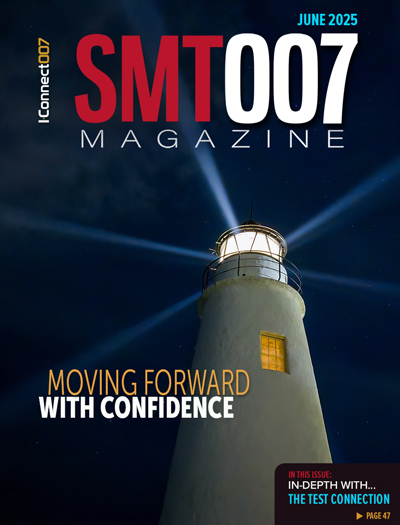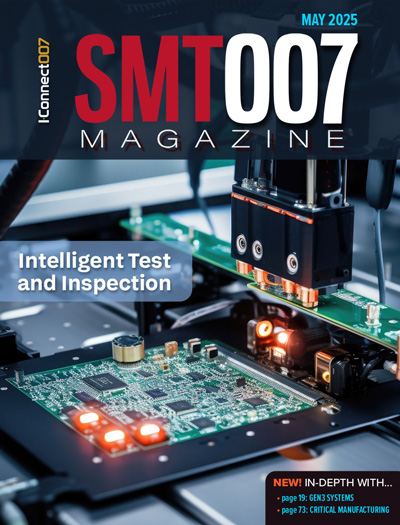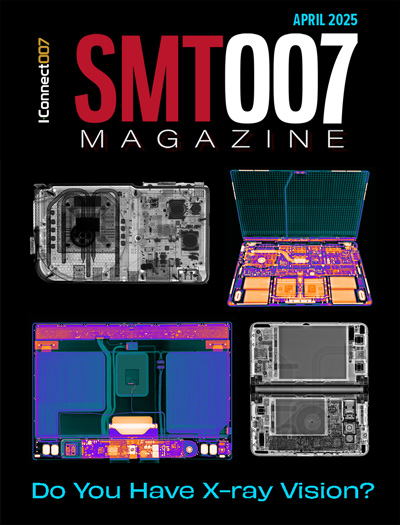-

- News
- Books
Featured Books
- smt007 Magazine
Latest Issues
Current Issue
Moving Forward With Confidence
In this issue, we focus on sales and quoting, workforce training, new IPC leadership in the U.S. and Canada, the effects of tariffs, CFX standards, and much more—all designed to provide perspective as you move through the cloud bank of today's shifting economic market.

Intelligent Test and Inspection
Are you ready to explore the cutting-edge advancements shaping the electronics manufacturing industry? The May 2025 issue of SMT007 Magazine is packed with insights, innovations, and expert perspectives that you won’t want to miss.

Do You Have X-ray Vision?
Has X-ray’s time finally come in electronics manufacturing? Join us in this issue of SMT007 Magazine, where we answer this question and others to bring more efficiency to your bottom line.
- Articles
- Columns
- Links
- Media kit
||| MENU - smt007 Magazine
NASA, GE Aerospace Advancing Hybrid-Electric Airliners with HyTEC
September 17, 2024 | NASAEstimated reading time: 3 minutes
Hybrid-electric cars have been a staple of the road for many years now.
Soon that same idea of a part-electric-, part-gas-powered engine may find its way into the skies propelling a future jet airliner.
NASA is working in tandem with industry partner GE Aerospace on designing and building just such an engine, one that burns much less fuel by including new components to help electrically power the engine.
In this hybrid jet engine, a fuel-burning core powers the engine and is assisted by electric motors. The motors produce electric power, which is fed back into the engine itself—therefore reducing how much fuel is needed to power the engine in the first place.
High Tech Hybrid-Electric
The work is happening as part of NASA’s Hybrid Thermally Efficient Core (HyTEC) project. This work intends to demonstrate this engine concept by the end of 2028 to enable its use on airliners as soon as the 2030s.
It represents a major step forward in jet engine technology.
This jet engine would be the first ever mild hybrid-electric jet engine. A “mild hybrid” engine can be powered partially by electrical machines operating both as motors and generators.
“This will be the first mild hybrid-electric engine and could lead to the first production engine for narrow-body airliners that’s hybrid electric,” said Anthony Nerone, who leads the HyTEC project from NASA’s Glenn Research Center in Cleveland. “It really opens the door for more sustainable aviation even beyond the 2030s.”
The hybrid-electric technology envisioned by NASA and GE Aerospace also could be powered by a new small jet engine core.
A major HyTEC project goal is to design and demonstrate a jet engine that has a smaller core but produces about the same amount of thrust as engines being flown today on single-aisle aircraft.
At the same time, the smaller core technology aims to reduce fuel burn and emissions by an estimated 5 to 10%.
How Does It Work?
A GE Aerospace Passport engine is being modified with hybrid electric components for testing.
“Today’s jet engines are not really hybrid electric,” Nerone said. “They have generators powering things like lights, radios, TV screens, and that kind of stuff. But not anything that can power the engines.”
The challenge is figuring out the best times to use the electric motors.
“Later this year, we are doing some testing with GE Aerospace to research which phases of flight we can get the most fuel savings,” Nerone said.
Embedded electric motor-generators will optimize engine performance by creating a system that can work with or without energy storage like batteries. This could help accelerate the introduction of hybrid-electric technologies for commercial aviation prior to energy storage solutions being fully matured.
“Together with NASA, GE Aerospace is doing critical research and development that could help make hybrid-electric commercial flight possible,” said Arjan Hegeman, general manager of future of flight technologies at GE Aerospace.
The technologies related to HyTEC are among those GE Aerospace is working to mature and advance under CFM International’s Revolutionary Innovation for Sustainable Engines (RISE) program. CFM is a joint venture between GE Aerospace and Safran Aircraft Engines. CFM RISE, which debuted in 2021, encompasses a suite of technologies including advanced engine architectures and hybrid electric systems aimed at being compatible with 100% Sustainable Aviation Fuel.
HyTEC, part of NASA’s Advanced Air Vehicles Program, is a key area of NASA’s Sustainable Flight National Partnership, which is collaborating with government, industry, and academic partners to address the U.S. goal of net-zero greenhouse gas emissions in aviation by the year 2050.
Suggested Items
TT Electronics Achieves ISO 13485 Medical Certification at Mexicali EMS Facility
06/27/2025 | TT ElectronicsThis milestone underscores TT Electronics’ commitment to delivering high-quality, compliant, and reliable manufacturing solutions to its global customers in healthcare and life sciences.
Elementary Mr. Watson: Retro Routers vs. Modern Boards—The Silent Struggle on Your Screen
06/26/2025 | John Watson -- Column: Elementary, Mr. WatsonThere's a story about a young woman preparing a holiday ham. Before putting it in the pan, she cuts off the ends. When asked why, she shrugs and says, "That's how my mom always did it." She asks her mother, who gives the same answer. Eventually, the question reaches Grandma, who laughs and says, "Oh, I only cut the ends off because my pan was too small." This story is a powerful analogy for how many PCB designers approach routing today.
Target Condition: From Dream House to Drill Files
06/05/2025 | Kelly Dack -- Column: Target ConditionIf you caught the movie “Barbie,” you may have laughed at its over-the-top utopia where every day begins with perfect weather, perfect smiles, and a perfectly pink commute. But beyond the plastic glam, the film subtly critiques the illusion of perfection—a message that feels surprisingly relevant to the world of PCB design and manufacturing.
Stephen Winchell Appointed DARPA Director
06/02/2025 | DARPAStephen Winchell was sworn in today as the 24th director of the Defense Advanced Research Projects Agency.
Uyemura Expands Engineering Team in Great Lakes Region
05/30/2025 | UyemuraAndrew Jin has joined Uyemura’s Engineering Team as Technical Service Engineer for the Midwest. Jin was formerly with Sensient Technologies, Flavors and Extracts Division, where his focus was CO2 emissions and water quality; he also did capital project work with production equipment.


